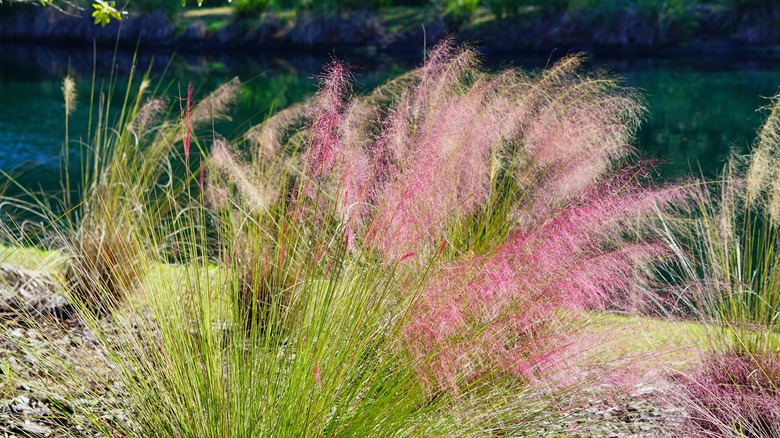Ornamental grasses add year-round interest to a home’s landscaping. In the spring, summer, and fall, their feathery foliage and color create the perfect backdrop for bold blooms. As the days turn cold and many plants in the landscape die back, ornamental grasses remain. Even when they turn brown for the winter season, they add texture to an otherwise forlorn-looking space. One of the best things about ornamental grasses is even though they add so much to our landscaped areas, most require very little water to look their best. However, for the first few months, it’s important to keep the soil consistently moist until the plants are established. Then you only need to water drought-tolerant ornamental grasses about every three weeks, unless it has rained.
Not only are they pretty and generally easy to grow, but ornamental grasses are also perennials. You only have to plant them once to get many years of enjoyment with minimal maintenance. Most of these kinds of plants simply need to be cut down in late winter to make room for new growth in the spring. There are so many beautiful options from which to choose, such as the pink muhly grass and blue oat grass. But whether you are looking for something compact for a container or a centerpiece for your landscaping, there are various options to consider.
Pink muhly grass

No list of beautiful ornamental grasses is complete without mentioning the pink muhly grass (Muhlenbergia reverchonii). Hardy in zones 5 to 10, this gorgeous plant is a favorite for a reason. In the spring, muhly grass emerges with flowing green foliage, but it is not until later in the summer season that pink muhly grass really puts on a show. At a time when many summer annuals are past their peak, this plant produces masses of tiny pink flowers, the culmination of which is reminiscent of cotton candy. At maturity, muhly grass reaches about 30 inches tall with an upright growth habit, making it the perfect background or filler plant.
Like most grasses, this cultivar is not picky about soil. You don’t need specialty fertilizer or perfect pH levels for pink muhly grass to thrive. To add this option to your landscape, dig a hole about twice as big as the root ball, add your plant, backfill the hole with soil, and water thoroughly. If you’re feeling extra generous, add 1 to 2 inches of compost to the soil’s surface for some extra nutrients.
Blue oat grass
If you are searching for a mounding grass that looks lovely alone as a border plant or as part of a landscape arrangement, consider blue oat grass (Helictotrichon sempervirens). Instead of having an upright growth habit like muhly grass, this cultivar creates beautiful soft mounds of neat round clumps. Blue oat grass grows up to 2 feet tall and 3 feet wide, so you will need to provide plenty of space so the rich, blue-tinted foliage of this plant can put on its show. Although it is hardy up to zone 3, it may only bloom in warmer climates with longer summers. In areas where it will bloom, it offers tall flower stems fringed with tiny light blue flowers. While this ornamental grass is drought-tolerant, it does not do well in extreme heat below zone 8.
Blue oat grass performs best in full sun but can tolerate a range of soils as long as it is not in an area that is frequently waterlogged. Place your young plants about 3 feet apart. This will give them plenty of room to fill out without being so crowded that their beautiful round mounds are not visible.
Pampas grass
Normazaro/Getty Images
For those looking to make a big statement using ornamental grass, look no further than pampas grass (Cortaderia selloana). When we say big, we mean that literally. At maturity, a clump of this dynamic plant reaches 10 feet tall and 6 feet wide, making it an alternative to a tree as the center of a landscaping arrangement. Although the grass itself offers interest and texture, what really stands out are the bloom stalks that emerge in late summer. Although they are often cut and used as indoor flower arrangements, when left over the winter, these flower stalks provide height and interest throughout the winter. There are several cultivars of pampas grass from which to choose, some of which are hardy from zone 6 and south.
You can plant pampas grass in areas that get four or more hours of direct sunlight a day. Once established, it requires very little water to thrive. The roots of this large grass are particularly useful for erosion control, so consider planting it on a slope or a bank where soil tends to wash away.
Mexican feathergrass
Nikolay Kurzenko/Shutterstock
Mexican feathergrass (Nassella tenuissima) is a versatile ornamental grass used in landscapes or for erosion control. Its compact growth habit even makes it a good option for containers since it only reaches about 2 feet tall. Considered a cool-season grass, this plant blooms in May, creating the feathery form that makes it so interesting. Adding to this light and airy texture is the whispy foliage. In fact, it is among the grasses with the finest texture, setting it apart from most other ornamental varieties. Mexican feathergrass is native to the Southwest U.S. region and is hardy from zone 7 and south.
Because this ornamental grass tends to reseed, it is best to use it in an area where you do not mind it spreading. Mexican feathergrass likes dry soil and full sun. It thrives in hot, dry conditions, making it a good option for southwestern climates or anywhere that does not get a lot of rain.

